Sketches
|
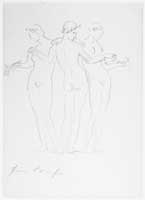
Three Graces, Pompeii (?)
Date?
|

Sketch for the Three Graces (Recto)
|
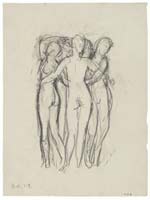
Sketch for the Three Graces . 2 (Recto)
|
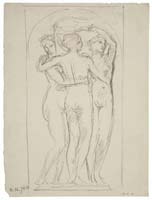
Sketch for the Three Graces . 4 (Recto)
|
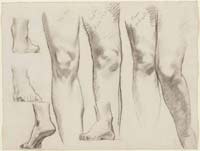
Sketch for the Three Graces - Legs and Feet . 5 (Recto)
|

Sketch for the Three Graces - One Study
|
|
The Three Graces
John Singer
Sargent -- American
painter
1921
Museum of Fine
Arts, Boston
Rotunda
Bas-Relief
Raised painted
plaster
Size?
Jpg: local
The Three Graces are an often used
iconographical subject in classical art. That Sargent has put them
center right once you reach the top of the stairs and enter the Rotunda
shows you the importance he places on them within his overall plan.
 The
Rotunda
The
Rotunda
From the top of the Grand
Stairway
They
are meant to be immediately recognizable and speak to an understood
reference of the female nude as art. Although they have been copied and
used by artists countless times, the vocabulary in how they are
expressed is often surprisingly (not always, but in the classical
since often) extremely narrow – three girls, dancing, getting ready to
dance, or embracing in a circle with two facing us and the one in the
middle facing away.
They are the three
daughters of Zeus and the nymph Eurynome and they are the goddesses of
“Radiance,” “Joy,” “Fruitfulness,” “Splendor,” “Mirth,” “Good Cheer,”
and many other things. Each, I believe, is to represent only one grace,
although through the difficulty of translation, or whatever, a general
grouping of many synonyms seem to get thrown on them. The three of them
preside over happy events amongst mortals and gods -- gatherings with
friends, dances and celebrations. They would also dance for Apollo to
the beautiful music from his lyre, and they would inspire mortal
artists with abilities – similar to the Muses.
When I first saw the
sketch of The Three Graces which Sargent did in Pompeii, I got excited that this
may have been his inspiration. But in trying to find the actual fresco
or painting of Sargent’s drawing, I began to understand the
overwhelming wealth for this iconography in art. My search then turned
more towards finding the inspiration of his exact pose for his final
version of the Base-Relief within the Rotunda.
Is there one?
Rubins, Raphael,
Burne-Jones,
and on
and on. Each seemed to have taken the challenge and spun it slightly
their
own way. Sargent, himself, toyed with different poses such as having
Apollo lifting in the lyre to the outstretched hands of the Graces in sketch #6. The more I looked the more perplexed I
became until I came upon the realization that maybe it’s not in the two
dimensional world I should be looking, but rather in the world of
sculpture and three-dimensional form. Sargent, you’ll remember, is
himself working in the three dimensions and he was never a trained
sculptor. So for him to try to find inspiration for help seems very
likely.
So, the journey then
took me from the classical world of Pompeii to the unlikely modern city
of Paris and the Louvre -- specifically -- a museum in which Sargent
must have visited countless times. Here we find two classical
sculptures of The Three Graces: one is Roman and one is Greek.
Interesting, isn’t it?
The latter is a sculpted relief of just the women’s bodies and legs
-- a blank canvas (of sorts) that any artist can imprint their
own interpretation upon. Notice the bend of the knees and the hips
suggesting the sway of dance – beautiful! Now if Sargent was to have
the girl on our right raise her arms to hold Apollo’s musical
instrument, would not the middle girl’s hand (which presumably had been
holding the right girl’s upper arm) naturally drop a little?
I’m not suggesting that
this was Sargent’s one and only inspiration, but I am suggesting this could have been a
strong one. And even if I don’t have it correct, the joy for me has
been in what Sargent has been able to teach me about the wider
understanding of what these three women represent and their
subsequent meaning at the MFA.

Rotunda Dome Decorations
Looking
straight up

Museum
of Fine Arts, Boston
Notes:
|
|

Unknown Roman Artist
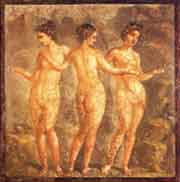
The
Three Graces
79
AD
Raphael
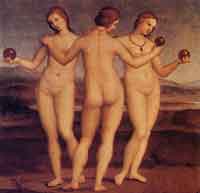
The
Three Graces
1504
Peter Paul Rubens
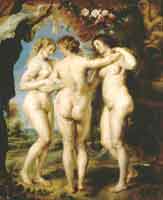
The
Three Graces
1639
Edward Coley
Burne-Jones
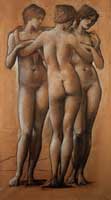
The
Three Graces
c.
1890-1896
Unknown Roman
Artist
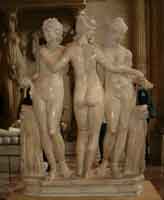
The Three Graces
1000 AD
Unknown Greek
Artist
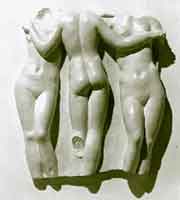
The Three Graces
c.
323-146 B.C |












